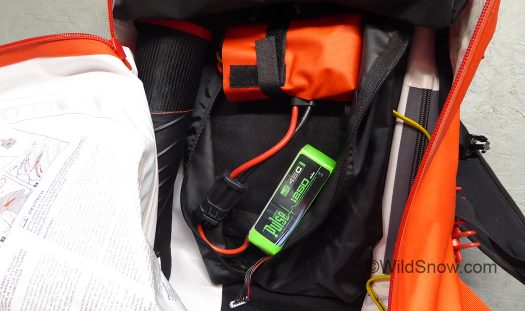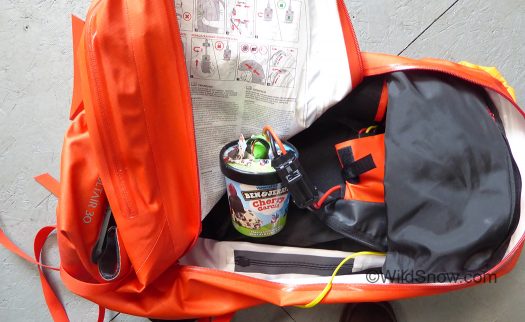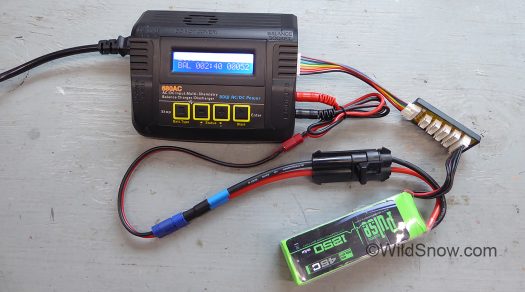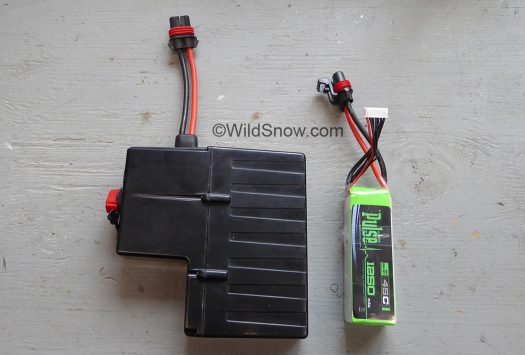When I got a first-look at the Arc’teryx Voltair early last winter, initial thought:“Beautifully designed, but the battery looks kinda big and heavy.”
Next thought: “Why?” Then of course, this being WildSnow.com: “How?”
After discussion with various insiders in the electric pack world, I’m told that the European standards for airbag packs are quite hard on fan packs. Some even told me the situation is downright ridiculous and discriminatory. It’s said this might be because the compressed gas side of the industry has biased the standards to their type of systems. Or it might simply be because ski touring gas actuated airbag packs have been around for decades, and the electronic balloon rucksacks are new and different enough to require somewhat different standards.
As an example of things the standards do not cover in favor of electronic packs: Multiple inflations or at least the numerous supplemental pulses (to compensate for a punctured or torn balloon) that both brands of electronic packs give you are nice if not wonderful features — some folks think they’re major advantages over single blast gas. Apparently the CE certification process doesn’t give a rip about about this, no pun intended.
In any case, consider Voltair, with a massive Lithium Polymer (LiPo) battery that puffs the balloon easily 14 times at room temperature, and will even do numerous inflations at subzero Fahrenheit temps. (LiPo batteries have reduced output when colder.)
Thus, my next question: Do I have to haul around extra weight I’ll never need, just to keep some nameless individuals in Europe happy about avalanche packs conforming to CE directives? Or so I can impress a large group of Germans at the Fanes Hutte by blowing the pack a dozen times in a row to drown out their robust beer singing? Perhaps not.
(To be fair, seeming as Voltair is from Canada, and people in Canada do ski in temperatures most of us would consider too chilly to venture outside, we can understand the gigantic battery. But again, do we all have to haul extra weight around just so the pack will function on Rogers Pass during a December morning in the dark, after a 12 hour bivouac?)
DISCLAIMER: This is a proof-of-concept. We are in no way advocating modifying your ski touring safety equipment.

LiPo 1250 mAh battery connected to Voltair pack, impressive performance, weight savings, and even a noticeable increase in cargo volume.

I used an ice cream carton to hold my cold soaked batteries so they wouldn’t warm too quickly from ambient indoor air. Should we call this the “Ben and Jerry” hack?
One of the best things about the Arc’teryx airbag backpack design philosophy is they kept it simple. The system does have a “black box” controller mounted in the pack above the battery, but this appears to do little more than time extra pulses and trigger an initialization gust when you first switch it on. It’s a small box, 6x3x12 centimeters and doesn’t weigh much.
The actual Voltair battery is somewhat “dumb” in that it includes a high amperage switch, probably some charging circuitry, and little else. So what’s to stop me from using a smaller and most importantly lighter weight battery? Little more than cost and some hardware hacking, actually.
The OEM Voltair battery is a Lithium Polymer (LiPo) multi cell pack that’s rated at 3,700 milliamp hours (mAH) capacity, 22.2 volts. That’s the same type or perhaps even identical to batteries used in devices such as radio controlled helicopters.
I purchased two Pulse Lipo brand batteries for my experiments, 1,800 mAh and 1,200 mAh. The math is easy. For example, if the 3,700 mAh battery gave me 14 inflations at room temperature, the 1,250 mAh battery should easily give me several, while the 1,800 mAh should exceed that by a couple of fills. (You can do firm math calcs on that, but because temperature and battery age change things on the fly, in my opinion it’s better to consider this in generalities — and test in real life.) After building the requisite connector adapters, my testing verified what the math says. I got plenty of fills at room temperature with either battery.

680AC Balance Charger is impressive, even has a 12v input for operation with vehicle or backcountry solar such as that at a cabin or hut.
LiPo batteries require a charger that does a careful, logic controlled job of feeding the batteries — at exactly set amperage and voltage. I acquired a 689AC LiPro Balance Charger. “…Rapid charger with high performance microprocessor and specialized operating software.” A few minutes of studying the manual and fiddling with buttons got me the best charge possible, including “balancing” the battery internal cells. WARNING: If improperly used you can damage batteries with this sort of charger — be very careful about the settings each time you charge.
The challenge is how these batteries would do after a cold soak. For most people, however, unrealistic to assume ski touring in temperatures that would cold soak the battery to below zero fahrenheit. If you do need that capability you know who you are, and the OEM Voltair battery is rated to provide inflations even when digits drop to subterranean levels. More, my experiments indicated the cold soaked and slightly larger 1,800 mAh battery would be entirely adequate at below zero temps (though where the exact temperature cutoff point is would have to be determined by more experiments.)
So, I tested the batteries by cold soaking for 3 hours in freezer at 0 fahrenheit (-18 C). Chilly. After two inflations I put them back in the freezer for another half hour, then finished the cold testing. I didn’t run the batteries down to failure (which damages the batteries), no reason to do so. I simply verified that they’d inflated the pack several times when cell temperature was a big fat Zero F. I’m delighted to report that both batteries performed surprisingly well. I did 4 inflations with the cold soaked 1800, and 3 with the 1250.
We have a chest freezer, so as an additional test I cold soaked the pack and 1250 battery at negative 2 degrees fahrenheit for 18 hours. I then tested and got two robust inflations along with 5 of the “pulse” blows per inflation, before disconnecting the battery.
During my cold soaking tests the number of inflations was NOT taken to the point of failure. As all you really need is one event — I’m calling that good.
Interestingly, the smaller battery does become warm to the touch when activated, and thus easily warmed itself from the cold soak. The larger one warmed up about 10 degrees F after each airbag activation. That means that even when cold soaked, after their initial trigger these batteries self-heat and easily provide the 10 extra “insurance” fill pulses that the Arc’teryx electronics control. This especially true if the battery is stored in an insulated location.
Weights:
1250 mAh Pulse LiPo: 7.3 oz, 222 grams (20 ounces, 567 grams savings from OEM)
1800 mAh Pulse LiPo: 11.4 oz, 324 grams (15.9 ounces, 450 grams savings from OEM)
3,750 mAh Arc’teryx: 27.3 ounces, 774 grams
This hack is not plug-and-play. I had to configure the correct connectors, and the Delphi Metri-Packs are not child’s play. Unless you know an electronics geek who’s an experienced hardware hacker, it’s probably DIY with the help of YouTube — and order multiple connectors so you have a few to practice on. I’d also advise storing the battery in a LiPo bag while it’s inside your pack. As a bonus, if you expect crypt temperatures you can throw a chemical hand warmer in with the battery (though doing so is not necessary for temperatures down to zero fahrenheit, according to my tests.)
For connectors, I permanently attached a Metri-Pack 480 female to the battery leads (this is the OEM Arc’teryx connector). For exact connector info see our cell phone wiring harness post. I made a wiring harness for the charger using a male Metri-Pack and an EC3 female to mate with the battery charger lead. Many ways go with attaching charger as it’s low amperage and comes with a large variety of preconfigured jumpers, important thing is a short high-current connection to the backpack that matches Arc’teryx use of flexible #10 wire (known as silicon “worm wire”). Youtube videos and soldering equipment made it all go well for me, though I’m glad I ordered extra connectors to support a steep learning curve.
Interestingly, the batteries are rated as 45C discharge rate (don’t get anything less) but have only a 12awg size wire lead. The battery wires do sport low-temp flexible silicon insulation (for high altitude RC aircraft flights?). While thicker 10awg silicon “worm wire” is clearly best for 44 amps, such as the cable used by Arc’teryx, in my testing the Pulse Lipo 12awg battery wire did not become warm to the touch, so they pass. Nonetheless, if using this hack in the field I’ll probably chase the 12awg wires with silicon “rescue” tape to prevent shorting if they crack from the cold or are otherwise damaged. Same goes for other wires as well. Like I said in previous blog post, it’s considered poor form to ignite your backpack.
Downsides: Important to test in the conditions you normally ski in, regarding temperatures. Cost isn’t that prohibitive but the charger and battery will set you back a bit. Perhaps the biggest problem is the lack of an “off” switch. With the aftermarket battery attached the system is always armed and “on.” To switch off you have to disconnect the battery. A 50 amp toggle or rotational switch could be added, but they’re heavy and you’d have to figure out a way to “safety” the switch so it wouldn’t get turned off accidentally. A nicer option and something I might still solder up is a disarming switch, which is simply a connector that’s configured to be yanked out of the circuit and thus turn everything off. Presently, I’m comfortable with controlling things by simply connecting and disconnecting the battery. You have to do so anyway for charging. Important, please again note this is an experiment, not a recommended mod. The RC batteries lack overload and short circuit protection, which the OEM Voltair battery has as built-in features.
Summary: With attention to detail with connectors and battery storage, this hack will look and perform “factory” while saving significant weight and even increasing the interior volume of the Voltair backpack. Clearly proven by my experiments above, if a smaller battery is used at less than horribly extreme temperatures, and stored next to your back inside the pack, it is entirely adequate for most people. I now have an Arc’teryx 30 liter electric avalanche airbag pack that only weighs 7 pounds (3,220 grams), but is easy for airline travel and eliminates the refill hassle you get with gas actuated packs. Not the lightest 30 liter airbag pack out there, but pretty good for an electric pack that’s somewhat overbuilt.
The airbag weight winner these days is probably the Mammut offerings, especially when graced with their European carbon cylinders. But those packs are not near as durable as the Arc’teryx, and again, remember that electric packs have advantages such as easy zero-cost recharge and pain free airline travel.
Please see all our extensive Voltair ski touring airbag backpack coverage.
The Arc’teryx Voltair will be available soon from selected retailers such as Backcountry.com
Safety note: As far as I know these RC purposed Pulse Ultra LiPo batteries do not have a protection circuit for a “dead short,” meaning the event of permanently crossing-connecting the positive and negative lead wires. While my research indicates it’s unlikely a shorted LiPo battery will actually become hot enough to ignite, it can pop open and emit a cloud of steam and the shorted wires themselves could ignite flammable materials. If this sort of mod becomes popular, some testing to failure would probably be wise.
While recent events with problematic cell phone batteries have increased awareness of battery safety, in my opinion it’s not a big deal. Firstly, most problems happen during charging and can be guarded against by simply locating your charger in a safe place. Secondly, regarding wire shorts, they’re usually going to be intermittent, thus causing sparking but not heating up the battery to any significant degree.
Perhaps most importantly, battery protection circuits also include deep discharge protection that could disable your airbag battery when you need those last few amps. My understanding is that one reason radio controlled aircraft batteries don’t have such protection is that landing the plane with battery dregs, and damaging the battery, is better than crashing the aircraft. Likewise, in a safety device, better to simply allow every last bit of power to be used if necessary. (Lack of deep discharge protection is one reason I did not deploy these batteries to total failure, nor did I do so with the OEM Arc’teryx battery).
Thus, WARNING: When experimenting with this system I noted that when the custom battery was connected to the backpack electronics, it powered up the system — with no on-off switch other than disconnecting the battery. That means that the battery is constantly discharged until disconnected. Two problems with that:
1.)Fail to disconnect and charge battery, but leave it connected, you’ll totally ruin the battery due to deep discharge (how long you have for this depends on the battery capacity).
2.)After a few days, the battery may be depleted to an unsafe level.
The obvious safety solution for battery shorting is to store the battery inside your pack in a Lipo case, and insulate the wires reliably with something that’s flexible at cold temperatures, such as silicon tape. Further, it could perhaps be wise to solder a section of fusible link wire into the battery leads. One would assume the OEM Arc’teryx battery has a protection circuit but I’ve not verified this. Interestingly, you can find dozens of battery protection circuit modules in the web. They’re tiny things, and cheap, so adding one into your mod could be an option. Though again, I don’t see this as particularly necessary provided you’re careful with battery handling and your electrical work. Any electrical engineers care to comment on that idea? Here is a video of a LiPo shorted out and taken to failure.
WildSnow.com publisher emeritus and founder Lou (Louis Dawson) has a 50+ years career in climbing, backcountry skiing and ski mountaineering. He was the first person in history to ski down all 54 Colorado 14,000-foot peaks, has authored numerous books about about backcountry skiing, and has skied from the summit of Denali in Alaska, North America’s highest mountain.

